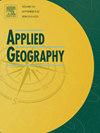‘Nature in the glass’: Principles and practices in low-intervention winemaking
IF 4
2区 地球科学
Q1 GEOGRAPHY
引用次数: 0
Abstract
Wine is often portrayed and perceived as a natural product; however, in fact, it's predominantly a highly industrialized, processed commodity. The vast majority of vine is cultivated in monocultural systems, requiring the intensive use of pesticides and agricultural machinery. Advanced cellar technologies and oenological practices standardize vinification, controlling and manipulating microbial and biochemical processes to ensure a uniform product. This approach has faced criticism, primarily due to its ecological implications. In response, a niche market has developed around so-called ‘natural’ or ‘low-intervention’ wines, emphasizing environmentally conscious production methods, resulting in a distinctive product. In a qualitative research approach, we explore the alternative practices which reflect the winemaker's care for soil and plant health, support microorganisms in the must, and preserve the wine's ingrediencies. Through practices like no-till, soil fertilization, and spontaneous fermentation, low-intervention winemakers aspire to stop soil degradation, regenerate their plants' microbiome and respect the grape's indigenous fermentation capacity, allowing in-situ yeasts to do their job and craft an individual wine flavour. Our article proposes a framework to explore these practices and the underlying philosophy, where the observed processes and winemaker's attitudes reflect an approach of ‘co-producing with nature’, which we explore by adopting conceptual ideas from more-than-human geographies.
“玻璃中的自然”:低干预酿酒的原则和实践
葡萄酒通常被描绘成一种天然产品,但事实上,它主要是一种高度工业化的加工商品。绝大多数葡萄树都是单一栽培,需要大量使用杀虫剂和农业机械。先进的酒窖技术和酿酒方法使葡萄酒酿造标准化,控制和操纵微生物和生化过程,以确保产品的统一性。这种方法受到了批评,主要是由于其对生态的影响。作为回应,围绕所谓的 "天然 "或 "低干预 "葡萄酒形成了一个利基市场,强调环保的生产方法,从而产生了与众不同的产品。通过定性研究方法,我们探索了反映酿酒师对土壤和植物健康的关注、支持葡萄汁中的微生物以及保护葡萄酒成分的其他做法。通过免耕、土壤施肥和自发发酵等做法,低干预酿酒师希望阻止土壤退化,使植物的微生物群再生,并尊重葡萄的本土发酵能力,让原地酵母发挥其作用,酿造出独具特色的葡萄酒。我们的文章提出了一个框架来探讨这些实践和基本理念,其中观察到的过程和酿酒师的态度反映了一种 "与自然共同生产 "的方法,我们通过采用 "非人类地理 "的概念来探讨这种方法。
本文章由计算机程序翻译,如有差异,请以英文原文为准。
求助全文
约1分钟内获得全文
求助全文
来源期刊

Applied Geography
GEOGRAPHY-
CiteScore
8.00
自引率
2.00%
发文量
134
期刊介绍:
Applied Geography is a journal devoted to the publication of research which utilizes geographic approaches (human, physical, nature-society and GIScience) to resolve human problems that have a spatial dimension. These problems may be related to the assessment, management and allocation of the world physical and/or human resources. The underlying rationale of the journal is that only through a clear understanding of the relevant societal, physical, and coupled natural-humans systems can we resolve such problems. Papers are invited on any theme involving the application of geographical theory and methodology in the resolution of human problems.
 求助内容:
求助内容: 应助结果提醒方式:
应助结果提醒方式:


